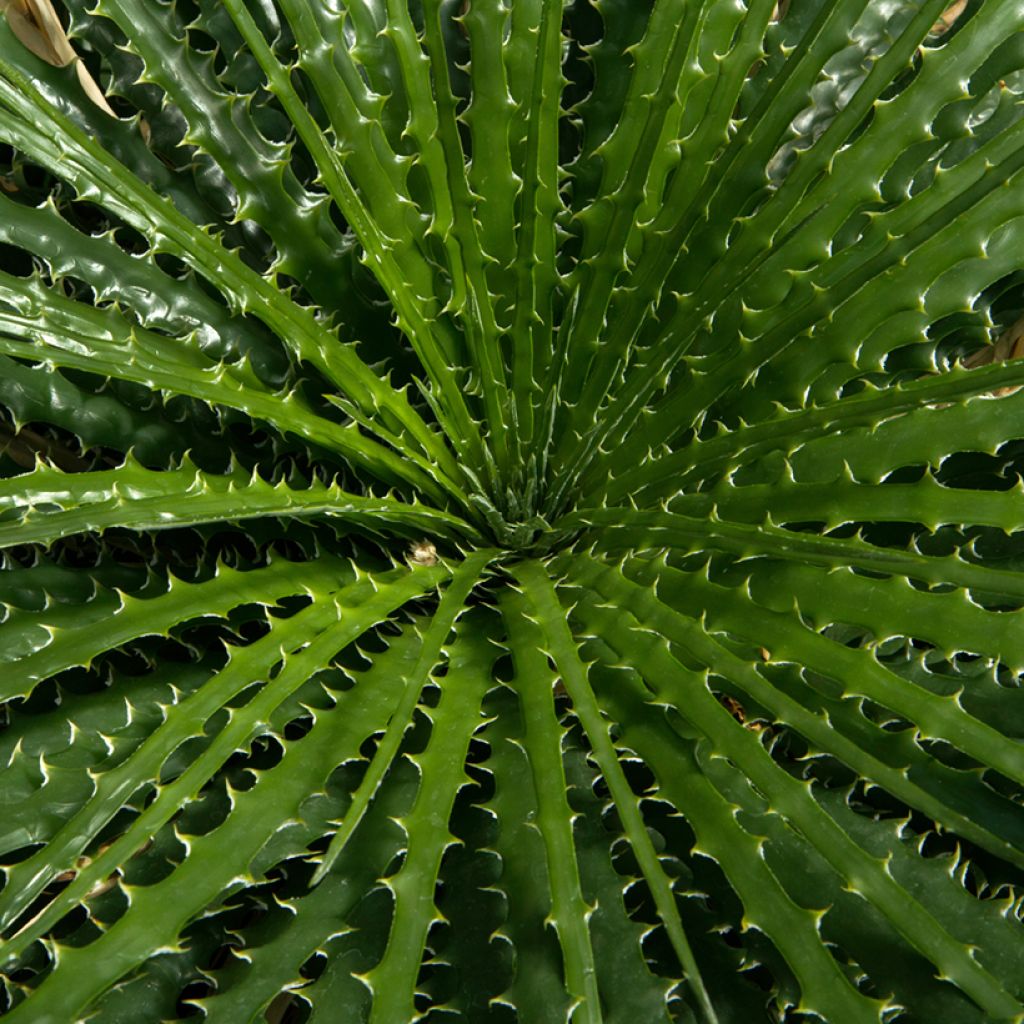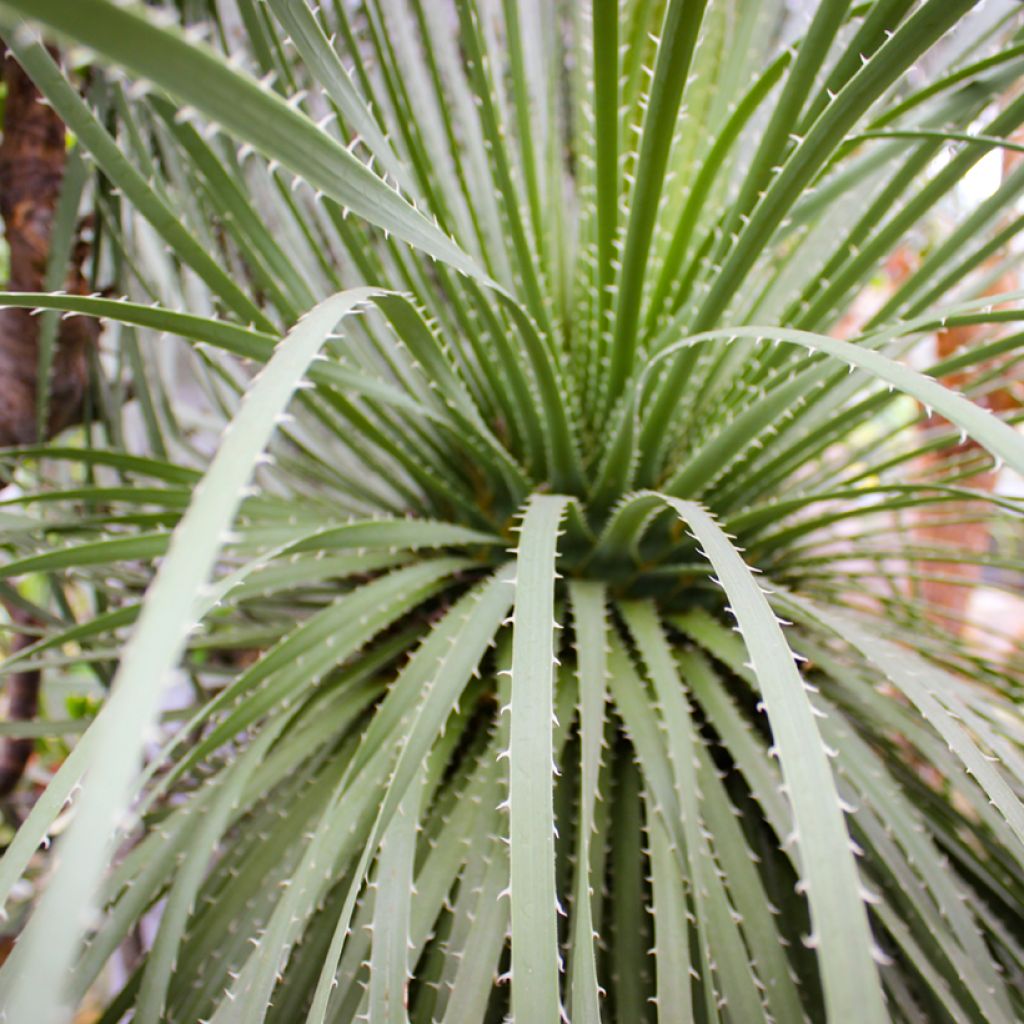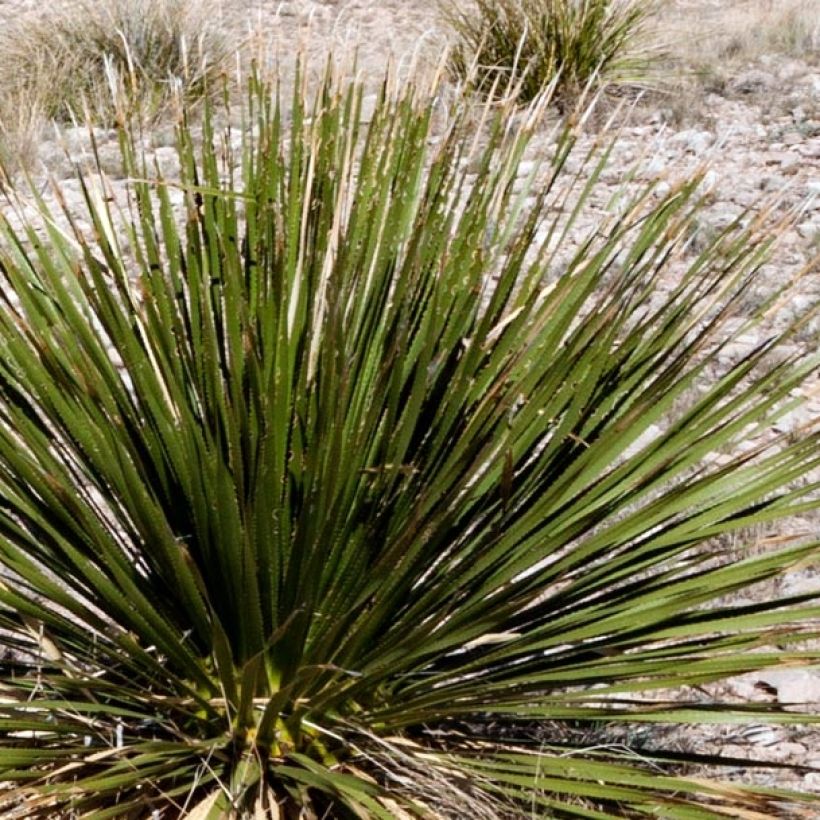

Dasylirion leiophyllum - Dasylire ou Sotol vert


Dasylirion leiophyllum - Sotol


Dasylirion leiophyllum - Sotol


Dasylirion leiophyllum - Sotol


Dasylirion leiophyllum - Sotol


Dasylirion leiophyllum - Dasylire ou Sotol vert
Dasylirion leiophyllum - Sotol
Dasylirion leiophyllum
Green Sotol, Smooth-leaf Sotol, Smooth Sotol
We've had it for two years, not complicated at all, in a field of young plants and big white stones all around. Lovely surprise! It's going to flower this year, its stem is 1.70m (6ft) tall with buds... we can't wait to see it bloom.
Maco, 28/06/2020
Special offer!
Receive a €20 voucher for any order over €90 (excluding delivery costs, credit notes, and plastic-free options)!
1- Add your favorite plants to your cart.
2- Once you have reached €90, confirm your order (you can even choose the delivery date!).
3- As soon as your order is shipped, you will receive an email containing your voucher code, valid for 3 months (90 days).
Your voucher is unique and can only be used once, for any order with a minimum value of €20, excluding delivery costs.
Can be combined with other current offers, non-divisible and non-refundable.
Why not try an alternative variety in stock?
View all →This plant carries a 24 months recovery warranty
More information
We guarantee the quality of our plants for a full growing cycle, and will replace at our expense any plant that fails to recover under normal climatic and planting conditions.
Would this plant suit my garden?
Set up your Plantfit profile →
Description
The Dasylirion leiophyllum is undoubtedly the hardiest of the Dasylirion. It is recognised by its lush green foliage, which has earned it the name of Green Sotol. It has very long, tapered, glossy, succulent leaves with formidable teeth. It is a trendy, architectural plant, decorative all year round, that requires very little but makes a statement on a contemporary terrace. Its very short trunk is hidden under a large rosette of radiant, regular and graceful leaves, from which emerges in summer, after many years, a long, pendulous flower spike, adorned with small whitish bells. The Dasylirion can be grown both in the ground and in pots. It is an excellent rock garden or dry garden plant to grow in poor, rocky or sandy soil.
Originally from an area ranging from West Texas to Southwest New Mexico and southern Mexico, the Dasylirion leiophyllum is capable of withstanding temperatures of around -18°C (-0.4 °F) in very well-drained soil, or even -20°C (-4 °F) in very dry soil. It will therefore adapt to many gardens, as long as it is planted in rocky or gravelly, very well-drained soil. Like all Dasylirions, it tolerates long periods of summer drought and is indifferent to the presence of limestone.
It is a rhizomatous plant belonging to the Agave family, slow-growing in dry soil, faster in moist soil. When young, the Dasylirion forms a dense, shaggy ball. After many years, it can form a partially underground false trunk, covered with the remains of old leaves, brown in colour, forming a kind of skirt. These can be cut to highlight the trunk. The trunk often ends up lying down without stopping growing. It bears a spherical crown measuring 1m (3 ft 4 in) to 1.30m (4 ft 4 in) wide, composed of several hundred succulent, radiant leaves, flat on top but cylindrical underneath, 50 cm (19.7 in) to 1 m (3 ft 4 in) long, 1 cm (0.4 in) wide, with initially green, then yellow-orange hooked teeth. The leaves are slightly flexible and arched. Flowering occurs after 10 to 15 years of cultivation, in summer. A thin, upright flower spike emerges from the centre of the rosette at 2 m, among the leaves. The tiny cream-colored bell-shaped flowers are tightly packed together in the upper part of the flower spike which for a long time, often until winter. Male plants are distinct from female plants. When watered during the summer, this Dasylirion shows spectacular growth. When choosing a location for the plant, it's essential to be careful and avoid disturbing its fragile root system. This plant doesn't handle transplantation well, unlike the agave. It's worth noting that the dasylirion is not a monocarpic plant, meaning the rosette won't die after flowering. Instead, a lateral bud on the plant's central axis will take over.
The Dasylirion leiophyllum is an architectural succulent plant that seduces with the graceful symmetry of its foliage. Superb in a large pot with simple shapes, it is perfect in a minimalist garden. Give it plenty of sunlight and soil that does not retain water, as does not tolerate heavy, wet soil in winter. It is perfect on a large arid slope, at the top of a large exotic or contemporary rock garden, or even near a swimming pool, if the soil is well prepared to accommodate it. To cover the base, consider using a carpet of silver basket, Cerastostigma plumbaginoides, Delosperma or even a dry grass meadow like Zoyzia tenuifolia Mascarene grass. It can be paired with agaves, prickly pears, relatively hardy candle cacti such as Cleistocactus strausii and Cylindropuntia imbricata, and equally stunning and drought-tolerant bushy aloes.
Report an error about the product description
Dasylirion leiophyllum - Sotol in pictures






Plant habit
Flowering
Foliage
Botanical data
Dasylirion
leiophyllum
Agavaceae (Asparagaceae)
Green Sotol, Smooth-leaf Sotol, Smooth Sotol
North America
Planting and care
Plant Dasylirion leiophyllum during spring in a location that receives abundant sunlight and ensures it is protected from rain if the soil becomes waterlogged during winter. A well-established subject can endure brief frosts of around -15°C (5°F) in well-drained soil and even lower temperatures in dry, rocky, gravelly, or sandy terrain. It is advisable to shelter young plants from winter rain, especially the heart and base since they are more vulnerable than well-established subjects. The growth of this plant is slow, but it can be boosted by providing generous yet spaced watering during summer and fertile soil. Autumn planting is preferable in mild climates, especially during hot and dry summers. Transplantation requires some precautions: remove the root ball without damaging it and taking care of the roots to avoid compromising the plant's health. This species is not well-suited to heavy and humid soils, especially in cold climates. Ideally, planting the Dasylirion leiophyllum in a large rockery, on a slope, on a raised bed with gravel-enriched soil, or on a rocky embankment is best.
On the other hand, this plant does not require a specific soil pH and can tolerate slightly acidic, sandy, stony, or even very chalky soil. Dasylirion tolerates poor soil, but its growth will be faster in fertile soil. During the first two years, monitoring the watering, especially during hot and dry periods, is essential. Remove faded stems as needed.
If your dasylirion is not flowering, it is probably too young or has only been planted in your garden for 3 or 4 years. This plant takes time to establish itself and only flowers after 10 to 15 years, mainly in warmer areas. Depending on the sunlight and climate, it will flower every year or two or three years. If the plant benefits from automated drip irrigation in summer, its growth will be boosted and 5-year-old rosettes will be able to flower.
Planting period
Intended location
Care
-
, onOrder confirmed
Reply from on Promesse de fleurs
Similar products
Haven't found what you were looking for?
Hardiness is the lowest winter temperature a plant can endure without suffering serious damage or even dying. However, hardiness is affected by location (a sheltered area, such as a patio), protection (winter cover) and soil type (hardiness is improved by well-drained soil).

Photo Sharing Terms & Conditions
In order to encourage gardeners to interact and share their experiences, Promesse de fleurs offers various media enabling content to be uploaded onto its Site - in particular via the ‘Photo sharing’ module.
The User agrees to refrain from:
- Posting any content that is illegal, prejudicial, insulting, racist, inciteful to hatred, revisionist, contrary to public decency, that infringes on privacy or on the privacy rights of third parties, in particular the publicity rights of persons and goods, intellectual property rights, or the right to privacy.
- Submitting content on behalf of a third party;
- Impersonate the identity of a third party and/or publish any personal information about a third party;
In general, the User undertakes to refrain from any unethical behaviour.
All Content (in particular text, comments, files, images, photos, videos, creative works, etc.), which may be subject to property or intellectual property rights, image or other private rights, shall remain the property of the User, subject to the limited rights granted by the terms of the licence granted by Promesse de fleurs as stated below. Users are at liberty to publish or not to publish such Content on the Site, notably via the ‘Photo Sharing’ facility, and accept that this Content shall be made public and freely accessible, notably on the Internet.
Users further acknowledge, undertake to have ,and guarantee that they hold all necessary rights and permissions to publish such material on the Site, in particular with regard to the legislation in force pertaining to any privacy, property, intellectual property, image, or contractual rights, or rights of any other nature. By publishing such Content on the Site, Users acknowledge accepting full liability as publishers of the Content within the meaning of the law, and grant Promesse de fleurs, free of charge, an inclusive, worldwide licence for the said Content for the entire duration of its publication, including all reproduction, representation, up/downloading, displaying, performing, transmission, and storage rights.
Users also grant permission for their name to be linked to the Content and accept that this link may not always be made available.
By engaging in posting material, Users consent to their Content becoming automatically accessible on the Internet, in particular on other sites and/or blogs and/or web pages of the Promesse de fleurs site, including in particular social pages and the Promesse de fleurs catalogue.
Users may secure the removal of entrusted content free of charge by issuing a simple request via our contact form.
The flowering period indicated on our website applies to countries and regions located in USDA zone 8 (France, the United Kingdom, Ireland, the Netherlands, etc.)
It will vary according to where you live:
- In zones 9 to 10 (Italy, Spain, Greece, etc.), flowering will occur about 2 to 4 weeks earlier.
- In zones 6 to 7 (Germany, Poland, Slovenia, and lower mountainous regions), flowering will be delayed by 2 to 3 weeks.
- In zone 5 (Central Europe, Scandinavia), blooming will be delayed by 3 to 5 weeks.
In temperate climates, pruning of spring-flowering shrubs (forsythia, spireas, etc.) should be done just after flowering.
Pruning of summer-flowering shrubs (Indian Lilac, Perovskia, etc.) can be done in winter or spring.
In cold regions as well as with frost-sensitive plants, avoid pruning too early when severe frosts may still occur.
The planting period indicated on our website applies to countries and regions located in USDA zone 8 (France, United Kingdom, Ireland, Netherlands).
It will vary according to where you live:
- In Mediterranean zones (Marseille, Madrid, Milan, etc.), autumn and winter are the best planting periods.
- In continental zones (Strasbourg, Munich, Vienna, etc.), delay planting by 2 to 3 weeks in spring and bring it forward by 2 to 4 weeks in autumn.
- In mountainous regions (the Alps, Pyrenees, Carpathians, etc.), it is best to plant in late spring (May-June) or late summer (August-September).
The harvesting period indicated on our website applies to countries and regions in USDA zone 8 (France, England, Ireland, the Netherlands).
In colder areas (Scandinavia, Poland, Austria...) fruit and vegetable harvests are likely to be delayed by 3-4 weeks.
In warmer areas (Italy, Spain, Greece, etc.), harvesting will probably take place earlier, depending on weather conditions.
The sowing periods indicated on our website apply to countries and regions within USDA Zone 8 (France, UK, Ireland, Netherlands).
In colder areas (Scandinavia, Poland, Austria...), delay any outdoor sowing by 3-4 weeks, or sow under glass.
In warmer climes (Italy, Spain, Greece, etc.), bring outdoor sowing forward by a few weeks.











































